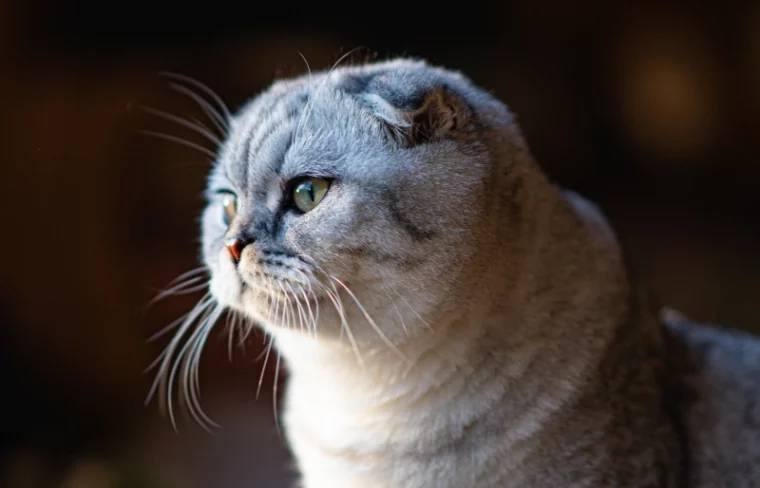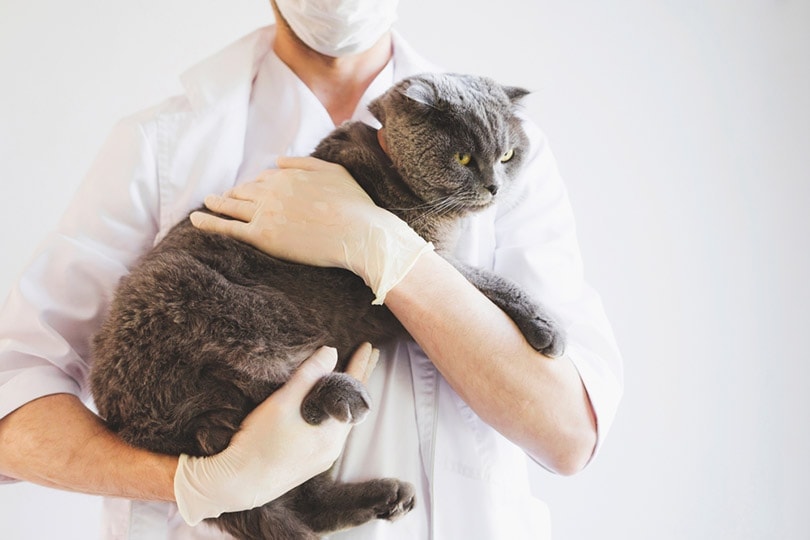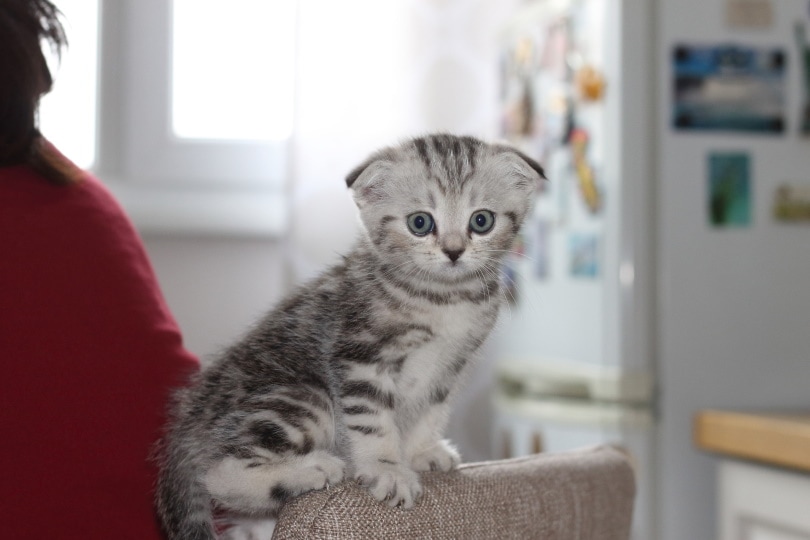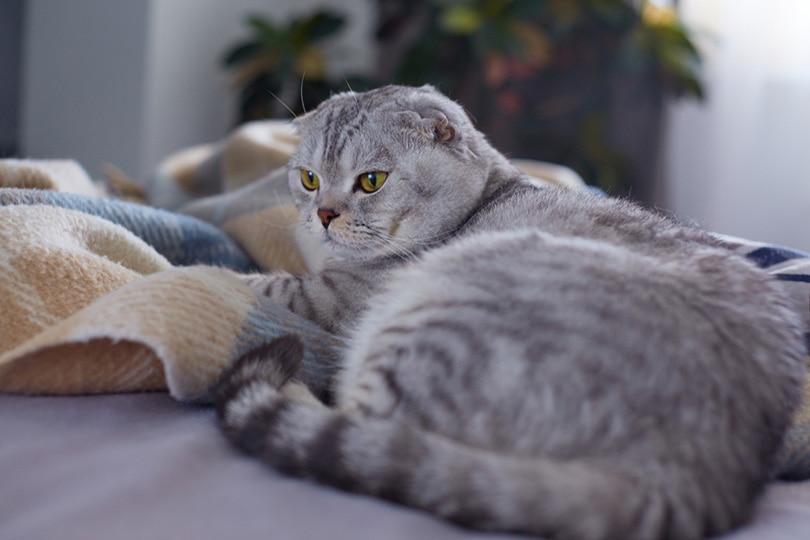
Click to Skip Ahead
The Scottish Fold is a genuinely endearing and sweet breed with an interesting, if somewhat painful, history. That’s because the cute, folded ears the cats are known for are also associated with a dreadful condition called osteochondrodysplasia. This degenerative joint disease (DJD) causes some Scottish Folds great pain and discomfort in their joints, especially their tails and hip joints. Fortunately, Scottish Folds tend to have long lives, with an average lifespan of 15 years.

What’s the Average Lifespan of a Scottish Fold?
The good news is that, despite their tendency to have DJD, Scottish Fold cats live long lives. For that reason, knowing how to care for, feed, and nurture your Scottish Fold is essential. The more you know, the less pain your kitty cat will have, and the longer it will probably live. The average lifespan of a Scottish fold is 15 years, which isn’t bad for a cat but not the longest-lived either. It’s essential that you care for your Scottish Fold well and take them for annual checkups with your local vet if you want them to live a long and healthy life. Read on to find out all the details and become a great Scottish Fold cat parent!


The 8 Reasons Why Some Scottish Folds Live Longer Than Others
As with all pets, many things factor into how long a cat will live, most having to do with caring for its health and providing a safe, caring environment. Below we’ll look at several critical factors that undoubtedly influence your Scottish Fold’s lifespan.
1. Nutrition

The best diet for a Scottish Fold cat is high in protein and has few if any, carbohydrates. Remember, felines are carnivores and don’t need a lot of plant-based food or food with carbs. They need protein from meat sources like duck, fish, and chicken. A high-quality diet will also reduce problems with DJD and thus reduce the chronic pain that many Scottish Folds experience.
2. Environment and Conditions
Keeping their joint issues in mind, you should create a living space for your Scottish Fold that’s easy to access. It should give your pussycat many places to hide and relax that don’t force it to climb or jump too often. Even the litter box you purchase can make a difference. The best boxes are lower on the side to make it easier for your cat to get in and out at potty time.
3. Size
The size of the average Scottish Fold male is about 12 pounds, while females weigh between 8 and 10 pounds on average. Remember that the heavier your Scottish Fold, the more weight on its joints and, in some cases, the more pain it will experience.
4. Sex
Like most cats, female Scottish Folds live slightly longer than males. Having your cat neutered or spayed will usually lengthen their lives by reducing aggressiveness and lowering the risk of health issues like cancer.

5. Genes
One of the factors you can’t control is the genes your Scottish Fold is born with. However, you can control who and where you adopt your Scottish Fold, which can make a huge difference in the cat you adopt. Responsible breeders know that breeding two Scottish Folds is dangerous due to the risk of osteochondrodysplasia and other genetic issues. You must find a reputable breeder when adopting your new kitten.
6. Breeding History
You must ask your chosen breeder, or the shelter where you find it, about the breeding history of your Scottish Fold. If they can’t tell you, you might want to keep looking.
7. Health Conditions

As mentioned, Scottish Folds are relatively healthy cats but suffer from a degenerative disease of their joints called osteochondrodysplasia. This condition affects the development of a Scottish Fold’s bones and cartilage, and it’s so concerning that, in Scotland, where they were created, the Scottish Fold isn’t even acknowledged by cat clubs.
It’s also worth noting that if your cat develops osteochondrodysplasia, it will need lifelong veterinary care to keep the condition from worsening and its pain under control.
Lastly, you should note that taking care of your Scottish Fold’s ears is a must, especially if they’re folded as is typical of the breed.
8. Activity
Scottish Folds aren’t the most active cats, it’s true, and many are even less active than other cats due to their joint and cartilage issues. However, if yours is healthy and young, providing toys, cat trees, and other items to keep them active is vital.

The 3 Life Stages of a Scottish Fold
Interestingly, the Scottish Fold matures a bit faster than many other breeds, reaching maturity at about 8 to 12 months.
1. Kitten (0 to 18 months)
You might be surprised that a Scottish Fold kitten’s ears aren’t flat at birth. If your kitten has the folded ear trait, their ears will flatten at 3 to 5 weeks.

2. Adult (18 months to 9 years)
Adult Scottish Folds are medium-sized cats with rounded heads, big, round eyes, and thick, short coats. Yours might have flat ears, or it might not. While the folded ears make the cat so popular, a Scottish Fold with straight ears will likely have fewer health issues and live a longer, healthier life.
3. Senior (9 years or older)
Preventing obesity in your senior Scottish Fold is critical, especially if they have joint pain from DJD and arthritis. Overfeeding should be avoided at all costs, and their kibble should be formulated for the needs of an older cat.

How to Tell Your Scottish Fold’s Age
If you’ve adopted an adult Scottish Fold, determining their exact age might not be possible. However, there are a few things you can look at that will give you a good idea, including the following:


Final Thoughts
While charming, friendly, and sweet, the Scottish Fold has suffered greatly due to its folded ears. The ears hide a genetic secret that causes joint problems some Scottish Folds suffer from their entire adult lives. Not all will be affected, especially Scottish Folds with straight ears, but many will be.
Finding a reputable breeder is essential if you’re seeking a Scottish Fold. This will lower the chance that your cat suffers from the dreaded osteochondrodysplasia and lives a longer, healthier, and happier life with less pain. Regular veterinary care and checkups are highly recommended. With prevention, good nutrition, and lots of TLC, your Scottish Fold should live a good life and make your life better and happier too!
- Related read: Is a Scottish Fold Hypoallergenic? Facts & FAQ
Featured Image Credit: michasekdzi, Pixabay





